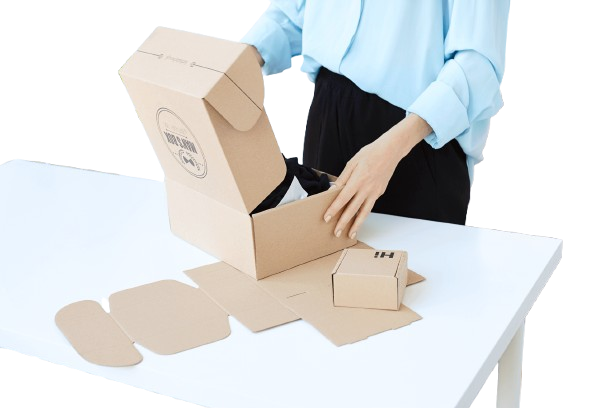Luxury packaging isn’t just about aesthetics — it’s about the experience, the brand story, and the protection of the product inside. Whether it’s high-end cosmetics, jewelry, or custom hair extension bags, the material used for luxury box packaging plays a pivotal role in defining the unboxing experience and ensuring customer satisfaction.
This comprehensive guide explores the most popular materials used in luxury box packaging, their pros and cons, and how to choose the best option based on product type and brand goals.
1. Rigid Box Board (Greyboard / Paperboard)
Overview
Rigid boxes are a staple in luxury packaging. Made from highly compressed paperboard (commonly greyboard), they’re sturdy, elegant, and customizable — ideal for premium branding.
Pros
- Extremely durable and protective
- Luxurious appearance and feel
- Supports magnetic closures, embossing, foil stamping, and lamination
- Recyclable and eco-friendly (depending on surface coating)
Cons
- Higher cost compared to folding cartons
- Heavier, which may increase shipping costs
- Not suitable for all product shapes (e.g., oddly shaped items)
Use Case Example: Hair extension kit bag sets often come in rigid boxes with magnetic closures for a premium finish.
2. Corrugated Board
Overview
Corrugated board, made from a fluted sheet sandwiched between two liners, offers durability and cushioning. It’s often used for outer shipping packaging but is also gaining traction in luxury gift boxes for eco-conscious brands.
Pros
- Excellent shock resistance
- Cost-effective
- Customizable thickness
- Sustainable and recyclable
Cons
- Less sleek appearance than rigid boxes
- Can appear utilitarian if not properly finished
- Limited in surface embellishment compared to rigid board
Use Case Example: A brand offering wholesale bags for hair extensions may ship products in branded corrugated boxes to combine protection with cost-efficiency.
3. Kraft Paperboard (Brown or Black Kraft)
Overview
Kraft board is unbleached, strong, and eco-friendly, known for its natural, earthy tone. Ideal for brands promoting sustainability, it’s a growing trend in luxury packaging.
Pros
- 100% recyclable and biodegradable
- Rustic, minimal, and organic aesthetic
- Great for natural beauty or eco-luxury brands
- Can be custom-printed with soy-based inks
Cons
- Less resistant to moisture
- Limited color palette and finish options
- Requires extra protection (coating or inserts) for fragile items
Use Case Example: Hair extension packaging bags wrapped in kraft boxes send a strong eco-conscious message.
4. Textured Specialty Paper (Velvet, Linen, Soft-Touch Coatings)
Overview
Specialty paper finishes add tactile and visual richness to rigid or cardboard boxes. Soft-touch, velvet lamination, or linen textures elevate the perceived value of the packaging.
Pros
- Adds premium tactile experience
- Supports a wide range of finishes
- Creates emotional and memorable unboxing experiences
Cons
- Increases unit cost
- May affect recyclability depending on lamination
- More prone to fingerprints or wear without protective coating
Use Case Example: A luxury hair extension kit bag enclosed in a velvet-laminated rigid box offers a high-end salon-grade feel.
5. Plastic (PET, PVC, or Recycled Plastics)
Overview
Plastic is still used in certain types of luxury packaging, especially where transparency or waterproofing is desired. It can be molded or printed for branding purposes.
Pros
- Water-resistant and durable
- Transparent options available
- Lightweight and shatterproof
- Can be reused for storage (adds value)
Cons
- Not environmentally friendly unless made from recycled plastic
- Often frowned upon by eco-conscious consumers
- Not as premium-feeling as rigid board
Use Case Example: Clear PVC bags for hair extensions or protective plastic windows within rigid boxes.
6. Foam Inserts & Fabric Linings
Overview
Often paired with rigid or corrugated boxes, foam inserts and fabric linings provide product cushioning while enhancing luxury. Satin, velvet, or suede are commonly used linings.
Pros
- Protects delicate items
- Enhances premium feel
- Custom die-cut inserts hold items securely
- Multiple material and color options
Cons
- Non-recyclable in most cases
- Increases production costs
- May require custom molds
Use Case Example: Custom hair extension bags can be placed inside a satin-lined rigid box for a VIP unboxing experience.
7. Magnetic Closures & Drawer Style Box Structures
Overview
While not a material per se, box structure plays a role in luxury perception. Magnetic flap closures and drawer-style boxes are often used with rigid boards.
Pros
- Reusable packaging with high-end appeal
- Secure closure system
- Popular for luxury hair extension kit bag sets
- Great for product bundling
Cons
- Complex to produce
- Bulkier storage and shipping
- Limited recyclability if magnets are not removable
Use Case Example: Brands offering hair extension packaging bags often opt for magnetic boxes to enhance brand prestige.
8. Metalized Paperboard or Foil-Laminated Board
Overview
This material involves layering metallic films over paperboard to achieve a high-gloss or metallic finish, ideal for brands wanting a futuristic or glamorous look.
Pros
- Eye-catching, high-luxury finish
- Reflective surfaces boost shelf appeal
- Ideal for festive or limited-edition packaging
Cons
- Harder to recycle due to mixed materials
- Prone to fingerprint smudging
- Higher production costs
Use Case Example: Limited-edition bags for hair extensions might be packed in foil-laminated gift boxes to amplify exclusivity.
How to Choose the Right Material for Your Luxury Packaging
Choosing the ideal packaging material depends on:
| Factor | Recommendation |
|---|---|
| Product Weight | Use rigid or corrugated board for heavy items |
| Eco-Friendliness | Opt for kraft or recycled paperboard |
| Budget Constraints | Corrugated and kraft offer luxury on a budget |
| Brand Aesthetic | Use specialty coatings or fabric linings for luxury feel |
| Reusability Value | Drawer boxes or magnetic flap boxes are best |
| Product Type | Hair extension packaging bags need sturdy, stylish boxes |
Why Materials Matter for Hair Extension Packaging
In the beauty industry, packaging plays a critical role in brand storytelling. When it comes to custom hair extension bags, the packaging isn’t just a protective layer — it’s a marketing asset.
- Durability: Hair extensions need secure containment to avoid tangling or damage. Luxury boxes with foam inserts offer the ideal solution.
- Reusability: Many users store their extensions in the same packaging. A drawer-style or magnetic rigid box becomes part of the long-term user experience.
- Presentation: First impressions count. Whether it’s for eCommerce, retail, or professional salons, high-end hair extension packaging bags reflect brand quality and professionalism.
Even smaller accessories — like bags for hair extensions or replacement kits — benefit from upscale packaging. Customers perceive more value when products arrive in elegant, purpose-designed boxes.
Sustainability: A Core Concern for Modern Luxury Brands
More than ever, luxury brands must think beyond visual appeal. Today’s consumer is environmentally aware. Opting for materials like kraft board, recycled greyboard, and minimalist designs not only reduces waste but also communicates responsibility and modern values.
If plastic elements are necessary (e.g., in PVC bags for hair extensions), consider offering guidance on recycling or encourage reuse.
Final Thoughts
Luxury box packaging is more than just a box — it’s an extension of the brand, a protector of products, and an experience in itself. Whether you’re packaging custom hair extension bags, premium cosmetics, or upscale gifts, the material you choose matters deeply.
By carefully weighing the pros and cons of each material — from rigid board to kraft paper and specialty coatings — brands can craft packaging solutions that are elegant, practical, and aligned with both customer expectations and environmental priorities.


